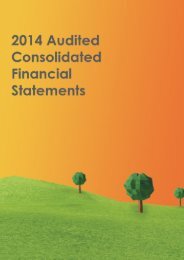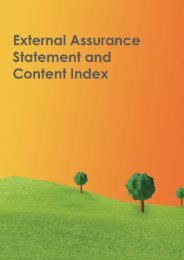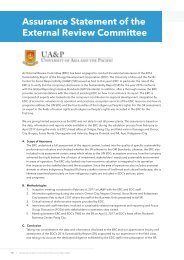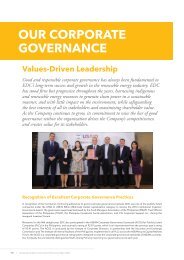EDC PR 2016 (FS section)
Create successful ePaper yourself
Turn your PDF publications into a flip-book with our unique Google optimized e-Paper software.
Financial Statement<br />
provision is presented in the profit or loss, net of any reimbursement. If the effect of the time<br />
value of money is material, provisions are discounted using a pre-tax rate that reflects, where<br />
appropriate, the risks specific to the liability. Where discounting is used, the increase in the<br />
provision due to the passage of time is recognized as “Interest expense” in the consolidated<br />
statement of income.<br />
Contingencies<br />
Contingent liabilities are not recognized in the consolidated financial statements. These are<br />
disclosed unless the possibility of an outflow of resources embodying economic benefits is<br />
remote. Contingent assets are not recognized in the consolidated financial statements but disclosed<br />
when an inflow of economic benefits is probable.<br />
Capital Stock<br />
Capital stock is measured at par value for all shares issued. When the Parent Company issues<br />
more than one class of stock, a separate account is maintained for each class of stock and the<br />
number of shares issued. Capital stock includes common stock and preferred stock.<br />
When the shares are sold at premium, the difference between the proceeds and the par value is<br />
credited to the “Additional paid-in capital” (APIC) account. When shares are issued for a<br />
consideration other than cash, the proceeds are measured by the fair value of the consideration<br />
received. In case the shares are issued to extinguish or settle the liability of the Parent Company,<br />
the shares shall be measured either at the fair value of the shares issued or fair value of the liability<br />
settled, whichever is more reliably determinable.<br />
Direct costs incurred related to equity issuance, such as underwriting, accounting and legal fees,<br />
printing costs and taxes are chargeable to the APIC account. If APIC is not sufficient, the excess<br />
is charged against the “Equity reserve” account.<br />
Treasury Stock<br />
The Company’s own equity instruments that are reacquired (treasury stock) are recognized at cost<br />
and deducted from equity. No gain or loss is recognized in the profit or loss on the purchase, sale,<br />
issue or cancellation of the Parent Company’s own equity instruments. Any difference between<br />
the carrying amount and the consideration, if reissued, is recognized in APIC. Share options<br />
exercised during the reporting period are satisfied with treasury stock.<br />
Common Shares in Employee Trust Account<br />
Common shares in the employee trust account, which consist of common shares irrevocably<br />
assigned to the Banco de Oro Trust and Investment Group (BDO Trust) account, are recognized at<br />
the amount at which such common shares were reacquired by the Parent Company for the purpose<br />
of its executive/employee stock grant or such similar plans, and proportionately reduced upon<br />
vesting of the benefit to the executive/employee grantee of the related number of common shares.<br />
This account is shown as a separate line item in the equity <strong>section</strong> of the consolidated statement of<br />
financial position.<br />
Employee Stock Ownership Plan<br />
Awards granted under the employee stock option plan of the Parent Company are accounted for as<br />
equity-settled transactions. The cost of equity-settled transaction is measured by reference to the<br />
fair value of the equity instruments at the date it is granted. Such cost, together with a<br />
corresponding increase in equity, is recognized over the period in which the performance and/or<br />
service conditions are fulfilled ending on the date on which the grantee becomes fully entitled to<br />
the award (“vesting date”). The cumulative expense recognized for equity-settled transactions at<br />
each financial reporting date until the vesting date reflects the extent to which the vesting period<br />
209
















